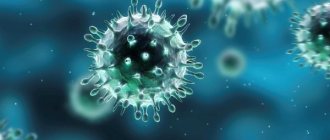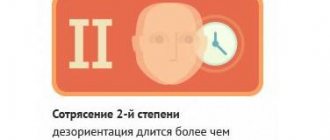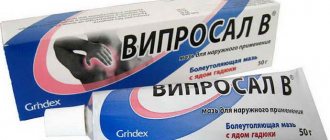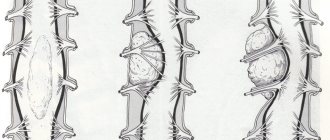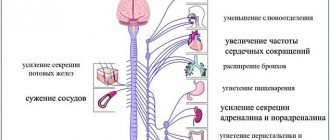Elena Anatolyevna Bardukova, neurologist, homeopath, 23 years of work experience ✔ Article verified by a doctor
Back neuralgia is a common symptom that most often signals certain pathologies of the spine. Pain may appear in the projection of the heart, liver, lung, epigastric region. Acute back pain and intercostal neuralgia are often mistaken for a serious disease of internal organs, but in 70% of cases such symptoms indicate neurological disorders.
Neuralgia rarely poses a threat to the patient’s life, but it is not easy for a person to live with regular “shots” in the back or under the ribs and inflammation of the nerve roots. Symptoms may appear suddenly, then disappear, but after some time they “come back” again.
Neuralgia of the back is manifested by pain due to compressed nerve roots
The main causes of pain and spasms in muscles are irritation and pinched nerves. As a rule, doctors prescribe effective medications that the patient takes at home. If treatment is started in time, pain can be dealt with as quickly as possible.
What is neuralgia of the back
So, any neuralgia occurs as a result of irritation of certain parts of the nerve pathways. The cause of pain depends on which area is affected and where it is located.
From the school anatomy course we know that 12 pairs of nerve fibers pass between our ribs. They are connected by pathways with the thoracic branches. Each space between the ribs in a person has paired formations - on the left and on the right.
The vapors, which are located below, go towards the anterior abdominal wall, so with neuralgic symptoms, pain can radiate to the abdomen.
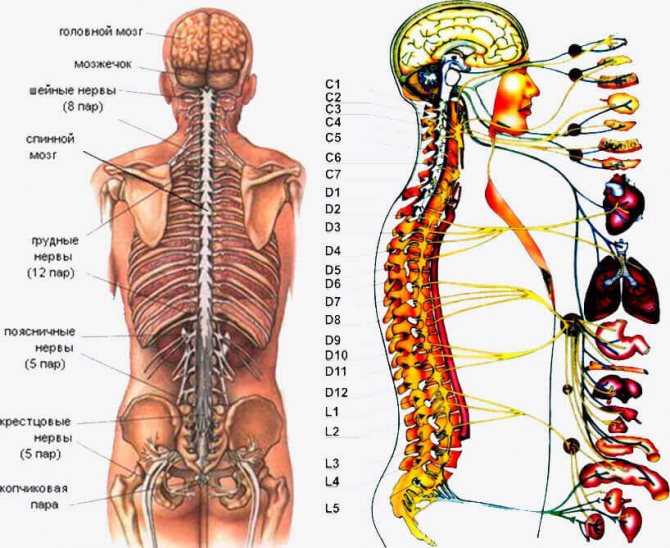
Nerve roots run through the entire spine
There are several types of branches in the peripheral nervous system:
- sensitive;
- motor;
- vegetative.
Depending on which of them is affected, different symptoms appear. If sensitive nerve endings are involved in the pathological process, pain occurs. If the motor pathways are affected, breathing problems (shortness of breath) may appear, and if the disease affects the autonomic peripheral nerves, patients experience increased sweating.
NSAID medications
Pharmacy products NSAIDs are non-steroidal drugs characterized by a pronounced anti-inflammatory effect. With their help, it is possible to localize neuralgic syndrome, reduce the intensity of pain and attacks, and significantly improve the general condition of patients faced with a disease of the nervous system.
Drug therapy for neuralgia involves the use of a wide range of medications of this type. The most common of them include: Diclofenac, Ortofen, Ibuprofen, Ketoprofen, Piroxekam, Voltaren, Indomethacin. Such drugs and their analogues are available in the form of tablets and capsules.
In addition to the form of tablets and capsules, NSAID drugs are available in the form of rectal suppositories and injections. Ointments, creams, gels, and special patches are produced for external use. These include Diprilif, Voltaren, Ketonal, Nise, Diclofenac and other analogues with a similar composition. When using NSAIDs for external use, it is recommended to handle them carefully, carefully rubbing them into areas of pain, excluding pressing and massaging the inflamed areas. Special patches, which include Ketonal Thermo, are considered a modern alternative to applications with ointments, creams, and gels.
Main symptoms and signs
People describe back pain due to neuralgia in different ways. She may be:
- strong;
- sudden;
- aching;
- paroxysmal;
- constant.
The pain becomes stronger with sudden movements, coughing, sneezing. In severe cases, an attack can even be triggered by a sudden change in body position.
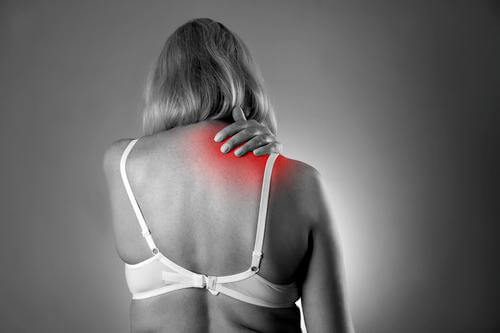
With neuralgia of the back, the pain can have a different character
How long can your back hurt with neuralgia? After two to three weeks, if left untreated, the pain may gradually subside. This means that one of the nerve roots has died, but the patients’ joy, alas, can be premature.
In the presence of provoking factors, manifestations return with renewed vigor. They are accompanied by spasms of the back muscles. They begin to involuntarily contract and twitch. The feeling is not pleasant, so you should not self-medicate - for example, take antibiotics and other medications without a doctor’s prescription.
Cervical region
When a nerve is damaged in the cervical spine, pain quickly spreads to nearby vertebrae and manifests itself in an unusual way:
- occurs unexpectedly, can be provoked by a sharp turn of the head to the side or even by ordinary touch;
- differs in different localization. First, it grabs the bottom of the neck, after which it spreads to the back of the head, behind the ears, and later “shoots” into the eye. This means that the facial nerve is involved in the pathological process;
- Patients often compare the resulting pain to an electric shock.

. In addition to pain, cervical neuralgia is characterized by photophobia and vertebral artery syndrome, caused by impaired blood flow. It can manifest itself as sharp “shooting” in the head on one side or in the back of the head (like a migraine) and unpleasant sensations while combing hair. Also observed:
- sweating, weakness;
- tinnitus;
- darkening of the eyes;
- hearing loss;
- sleep disorders;
- high pressure.
Thoracic region
If the process develops in the thoracic spine, the pain syndrome is predominantly of a girdling nature, radiating to different parts of the back, between the shoulder blades and to the upper lumbar region. When a stabbing sensation appears on the left (in the area of the heart), patients think that they have angina, a heart attack or heart failure, but this is not always the case.

Neuralgia in the thoracic region can be similar to pain in the heart
In this case, a competent attending physician must conduct a differential diagnosis, excluding or confirming cardiac pathology. There are a number of differences thanks to which a person can draw primary conclusions and understand which doctor he should contact:
- Intercostal neuralgia differs from a heart attack by constant aching pain;
- pain syndrome often occurs at night. It is accompanied by a feeling of fear and a feeling of lack of air, but if you remain calm and breathe deeply, the symptoms of suffocation go away. Towards the morning, the unpleasant sensations disappear without a trace, but later they can resume;
- The pain is accompanied by symptoms of muscular neuralgia. These are spasms and convulsions: patients describe this feeling something like this: “it’s as if a stake has been inserted in the back between the shoulder blades, and the back muscles become stone”;
- the pain intensifies if you take a deep breath, turn sharply or change body position.
Lumbar
If your back is “blown” in the lumbar region, pain of varying degrees of severity appears along the nerves of the lower parts of the spinal column. The process hinders movement, the person cannot stand or sit quietly. The muscles gradually swell and begin to contract involuntarily.
Great article on the topic:
Blown back: 15 symptoms and reasons, what to do, how to treat it at home, ointments, injections, patches, tablets
Pain in the lower back is always unpleasant, but it frightens patients much less than thoracic neuralgia. However, if we are talking about a pinched sciatic nerve, the severity of the symptoms increases several times and may be accompanied by temporary complete immobilization.

For neuralgia in the lower back, many people immediately take a strong painkiller pill
The sciatic nerve is one of the longest and largest in our body. It is responsible for the motor activity of the legs, so if it is damaged, a person may fall from unexpected and sharp pain. How does this type of neuralgia manifest? It all depends on the stage of the process. In the acute phase, sensations can be sharp and intense, and when the disease becomes chronic, the symptoms disappear. During an objective examination, the doctor discovers muscle weakness in the affected limb. In advanced cases, it is accompanied by flaccid paresis.
The nature of the spread of pain is from the upper part of the lower back down, along the back of the thigh, lower leg, to the toes. As a rule, one leg hurts, left or right, and if a person tries to step on it, an acute piercing pain occurs, which can be impossible to bear without the use of strong painkillers.
Be sure to read this good article:
Inflammation of the sciatic nerve (sciatica): TOP 50 methods of quick treatment at home
Neuralgia of the hands and feet
Neuralgia of the arms or legs is a secondary symptom that occurs as a result of degenerative diseases of the spine. Because the nerve pathways malfunction, “burning” pain may appear in the arms or legs. This is a very unpleasant feeling:
- it appears suddenly, the sensations are painful, pulling, the person cannot fully straighten the limb;
- in the legs, pain is usually localized posteriorly (along the sciatic nerve). Patients often limp, dragging their legs and stepping on them with great caution;
- in the hands, pain and cramps most often occur on the outer surface of the little finger on the right, when performing any movements. When they stop and gently bend the fingers inward, the unpleasant sensations gradually go away.
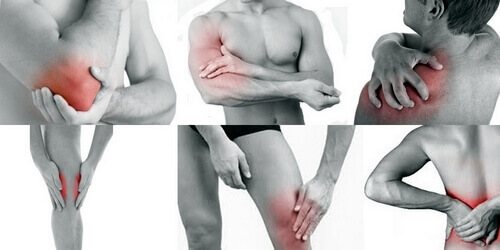
If you have neuralgia of the arms, we are probably talking about progressive thoracic osteochondrosis, and if cramps and spasms are observed in the legs, the sciatic nerve or roots in the lumbosacral spine are most likely pinched.
Causes
There are many reasons for the occurrence of such pain syndrome. Here are the ones that are most often encountered in medical practice:
- osteochondrosis and other degenerative lesions of the spine (protrusion, herniated disc). As a result of the gradual destruction of cartilage, discs and ligaments, the nerves running from the spinal column to the intercostal spaces are pinched. Most often, a person’s back and chest hurt;
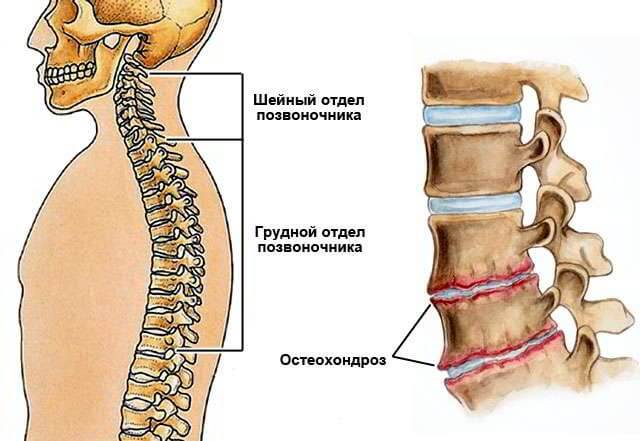
Osteochondrosis is a common cause of back neuralgia - colds (ARVI, acute respiratory infections), hypothermia. In such cases, people say: “I have a cold in my back.” Common phenomena in this case are muscle spasms, pain, discomfort in the lumbar region and between the shoulder blades;
- tight underwear. If a woman constantly wears an uncomfortable bra with large underwires, they put pressure on the surrounding tissue. Tight corsets and tight tights can also cause compression of internal organs;
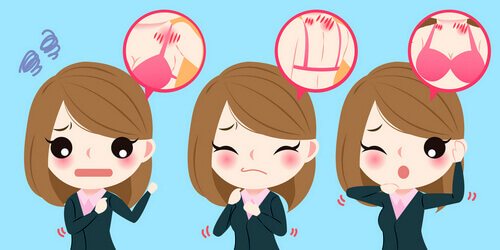
Uncomfortable underwear can also cause neuralgia in women - prolonged stay in an uncomfortable position. The pain occurs suddenly and passes quickly;
- herpes or shingles. An unpleasant viral disease with characteristic rashes on the chest and back, along the intercostal nerves. In the absence of thorough treatment or severe cases, the rash and itching on the skin may soon disappear, but the pain remains and torments the person for many months. In such cases, doctors talk about postherpetic herpes zoster neuralgia. The syndrome occurs more often in older people or in people with low immune defenses;
- severe physical activity and spinal injuries associated with them. A typical phenomenon in this case is pinching of the sciatic nerve with all the ensuing consequences. Patients describe the painful sensation in simple words, for example, “the leg hurts from the back” or “a sharp pain radiates to the leg”;

High load on the back or a sedentary lifestyle will sooner or later lead to neuralgia - diabetes. In its serious forms, the body's metabolism is disrupted and toxins gradually accumulate. Together with the blood, they “get” to the spine and negatively affect the nerve roots of the spinal cord;
- multiple sclerosis. Like diabetes, this is a severe systemic pathology, accompanied by complete or partial immobilization of the patient. Over time, spinal neuralgia with pain radiating to the ribs joins the main symptoms. Also, with multiple sclerosis, trigeminal neuralgia may be observed;
- benign and malignant formations. The reason for attacks of pain is simple: as any tumor grows, it compresses nerve roots and bundles;
- severe stress and overwork. Large psycho-emotional stress can provoke the appearance of pain and burning in the back of unknown etiology. Sometimes patients ask whether itching of the back occurs with neuralgia. It is this that most often indicates the psychosomatic nature of the pain syndrome. In this case, the patient is recommended to consult a psychotherapist.
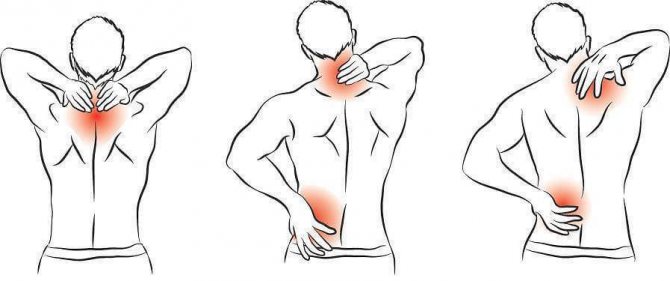
Stress often causes pinching in the shoulder blade area
Antispasmodics
With neuralgia, the muscle tissue surrounding the damaged nerve fibers spasms, their tone is excessively high. Without eliminating muscle spasms, you cannot get rid of pain. Increased tone is relieved with antispasmodics:
- Besalol;
- Halidor;
- No-spy;
- Papazol.
To eliminate spasms, they take pills and give injections.
Intercostal neuralgia requires complex therapeutic treatment. Thanks to it, pain is quickly relieved, the patient’s well-being is improved, and the inflammatory processes that cause the disease are blocked. Prescription of treatment by a doctor is a prerequisite. The prescribed medications will give the maximum therapeutic effect and will not allow complications to develop.
Do you still think that getting rid of osteochondrosis is not easy?
Have you tried all possible remedies, but the pain does not go away and prevents you from living a full life? Apparently yes, since you are reading these lines and not playing with your children and grandchildren.
Which doctor treats, how to diagnose
At first, it can be difficult to diagnose pathology if it is localized in the thoracic region. However, an experienced neurologist, by palpating (feeling) the pain point through the sternum, accurately determines its location. Heart disease does not produce such symptoms. Sometimes you can see slight redness near the source of pain. Based on additional tests, the doctor will be able to make an accurate diagnosis.
If a person has intercostal neuralgia, he unconsciously looks for a comfortable body position that helps reduce pain. Most often, he tilts the body in the “healthy” direction. This stretches the spaces between the ribs and relieves pressure on the inflamed nerves.

Most often, the patient is referred to a neurologist
The doctor can rule out another therapeutic or dangerous oncological disease based on collecting anamnesis from the patient and conducting a series of instrumental examinations. First of all, this is a chest x-ray. With its help, osteochondrosis and pneumonia are detected, which can sometimes also give neurological symptoms.
An electrocardiogram helps rule out angina and other heart diseases. In addition, it has a good psychological effect on the patient. If the ECG is normal, the doctor explains this. The person is clearly convinced that everything is fine with his heart and, together with the doctor, begins treatment for the spinal disease that caused this symptom.
Magnetic resonance and computed tomography are designed to identify degenerative processes in all parts of the spinal column. CTG and MRI show those pathological changes that are not recorded by radiography.
There is another effective diagnostic method called ENMG - electroneuromyography. It shows how active muscles are at rest, determines the speed of nerve impulses and damage to certain nerves.
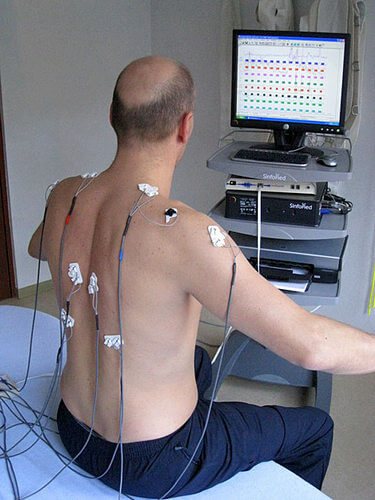
How is electroneuromyography performed?
Great article on the topic:
Does your back hurt? 9 doctors to consult for pain in the lower back, shoulder blades and neck
Patient diagnostic methods
If you suspect the appearance of neuralgia, contact a vertebrologist, neurologist or therapist. First, a visual examination is performed, palpation of the painful area, and an anamnesis is collected. Afterwards, tests and diagnostics are prescribed:
- X-ray of the spine in which the discomfort is localized;
- electrocardiography;
- MRI or CT;
- electromyography.
During the examination, it is important to separate dangerous conditions such as pneumonia and heart attack. Based on the results obtained, treatment tactics are drawn up.
What to do: first aid for acute neuralgia
If someone in your presence suddenly has a back or neck pain, you can use simple first aid tips. How to help and not harm:
- try to calm the patient down. In a state of tension and fear, muscle spasms and pain intensify;
- help him take a comfortable body position. If you have chest pain, let you lean slightly to the healthy side. If a person has lumbago in the neck, help him sit more comfortably, wrap the sore spot with a warm and light cloth. If there are symptoms of a pinched sciatic nerve, it is better to lay the patient on his stomach, on a flat and hard surface, covering him with a blanket and placing a cushion under his chest;
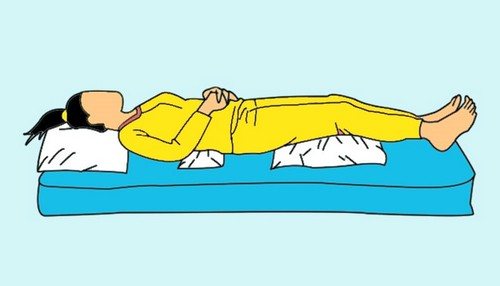
Posture for exacerbation of neuralgia of the back - in the acute stage of inflammation, do not use warming ointments. You can use a cooling gel (Bystrumgel, Deep Relief, Ben-Gay). It will have a mild analgesic effect;
- to relieve pain, give the victim a tablet of any analgesic that is found in the house (Analgin, Ketorolac, Diclofenac, Ortofen, Nise, Pentalgin);
- if the attack does not stop, call an ambulance. If the pain decreases, insist that the person contact a neurologist the next day and do not delay the visit to the doctor.
Correct choice of dosage form
External remedies for the treatment of intercostal neuralgia are available in the form of ointment, cream or gel. It is the latter dosage form (Voltaren, Artrosilene) that is effective at the beginning of therapy. Its components quickly penetrate the source of pain, exhibiting therapeutic effects after 5-10 minutes.
Ointment (Diclofenac, Ortofen) is thicker in structure and eliminates pain a little more slowly. It is like the cream (Teraflex) with a dense, viscous consistency. Their active ingredients are released gradually, providing long-lasting pain relief. Bioactive supplements are also produced in the form of balms. They have a thick jelly-like consistency and a pleasant smell of plant essential oils. It is advisable to use external agents in such dosage forms to eliminate aching, dull, seemingly distant pain.
Physiotherapy
Of the physiotherapeutic procedures, patients are most often recommended:
- microwave treatment (or magnetic therapy);
- Darsonval currents;
- UV irradiation (it is used even in the acute stage of the disease);
- therapy with ultra-frequency decimeter waves.
Any of these procedures improves blood circulation, restores nerve conduction and calms the person. Sometimes a combination of two methods is prescribed, which the patient takes in a certain sequence.
At home, you can use physiotherapeutic devices such as Almag-01 and Denas. These devices treat many diseases of the spine and joints. Therapy is carried out in courses.
Massage
For neuralgia of various etiologies, two types of massage are used:
- classical;
- can;
- spot.
The specialist begins a classic therapeutic massage by working on the healthy part of the back and neck, gradually moving on to the painful part. The duration of one course can be from 8 to 10 visits, 30-40 minutes each. Regular visits to a massage therapist will help cope with pain, relax muscles, improve blood and lymph flow, as well as the general condition of the body.
Be sure to read this good article:
Therapeutic back massage: how to do it correctly, types, benefits, principles
Acupressure is an effect on certain points located on the human body. They are in different places. The session takes place with the patient sitting on a chair. If you have thoracic neuralgia, you can learn one of the simplest techniques yourself. First, rub and stroke the ribs and intercostal spaces with your fingers, then move on to the areas located between the vertebrae. At the end of all actions, clasp your hands and stretch thoroughly.
Cupping massage is a very convenient treatment method at home. Thanks to vacuum massage, metabolism, blood circulation, lymphatic drainage are improved, and toxins are eliminated. After just one procedure, muscle spasms are relieved and severe pain goes away.
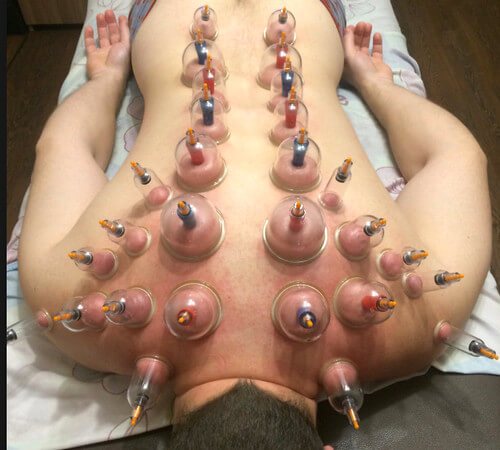
Silicone vacuum cups will help cope with even very severe pain
Prognosis, complications, prevention
And in the vast majority of cases, with timely treatment, neuritis of the shoulder joint has a positive prognosis for recovery, since the regenerative ability of the tissue is at a high level.
If you delay going to the hospital, the disease can provoke the development of the following complications: paralysis of the shoulder joint, contracture, atrophy of muscle tissue.
Prevention is a healthy lifestyle
In order to prevent the development of this disease, it is enough to follow these rules of prevention:
- avoid all kinds of injuries;
- promptly treat various inflammatory processes;
- maintaining an active lifestyle and playing sports to maintain muscle tone and strengthen the muscle corset;
- proper nutrition;
- To strengthen the immune system, regularly replenish the body's reserves of essential vitamins and minerals.
You should also monitor your body position during work, warm up during long monotonous activities, and undergo regular preventive examinations.
Therapeutic exercises
If your back hurts in the evenings, do not rush to immediately grab painkillers. How to deal with neuralgia on your own? A simple set of therapeutic exercises will help with this.
For the neck
- You can do it while sitting, but it’s better to do it while standing. Place your palm on your forehead and try to move your head forward, resisting it with your hand. Feel your neck muscles tense. Repeat the movement 5-10 times. Using the same principle, move your head back, “resisting” it with your hand placed on the back of your head. All that remains is to perform similar movements to the right and left sides, trying to reach your head with your shoulder.
- Slowly, without haste, tilt your head first to the right, then to the left. Repeat 5-10 times in each direction.
- Also slowly turn your head left and right, and then forward and backward.
- Slowly rotate your head, first clockwise and then counterclockwise. Repeat 5-10 times in both directions.
When performing these exercises, try not to rush or make sudden movements to avoid discomfort.
Video: exercises for neuralgia in the cervical region
For the chest
- Lie on your back, stretch your legs and bend your elbows so that they are perpendicular to your torso. You need to tense your chest muscles and slowly turn your clasped hands horizontally, trying to place them along your body. The “lock” must be carefully turned inside out. Feel how the dorsal and intercostal muscles stretch. Do 8-10 repetitions in each direction.
- Remain on your back. Bend your knees, lift your buttocks and extend both arms up. Start rolling left and right. The number of repetitions is from 8 to 10 times.
- Stand up straight, bend your arms at the shoulder joints and place them perpendicular to the line of your torso. Rotate your upper body alternately to the right and left. Try to keep your hands under your chest at all times and not move with your body. When moving, the pectoral and back muscles should tense. Repeat 8-10 times in both directions.
Video: exercises for neuralgia in the thoracic region
For the lumbar region
- Get on all fours, relax your lower back. Inhale and arch your back. As you exhale, try to bend your back in the opposite direction. Do 10-15 such repetitions.
- Remaining in the same position, place your leg straight and pull your opposite arm forward. Try to maintain your balance for a few seconds, then change the position of your arms and legs. Perform 5 to 10 sets on each side.
- Lie on your back, bend your legs at the knee joints, bringing your heels closer to your “fifth point.” Place your hands under your head and tuck your chin toward your chest. Stretch your elbows towards your knees, exhaling evenly. Take a deep breath, return to the starting position, and stretch your stomach. The number of approaches is 5-7 times.
- Remaining on your back, extend both arms along your body. As you inhale air, lift your pelvis, and as you exhale, lower it. Do 10-15 such repetitions.
Video: exercises for neuralgia in the lower back
Manual therapy
Sessions with a chiropractor will help “put in place” displaced vertebrae, ligaments and even discs. In some cases, chiropractors are able to save the patient from the need to undergo surgery.
The work of a chiropractor is to consistently influence different muscle groups so that they relax and it becomes possible to realign the displaced elements of the spine. Usually, the patient experiences great relief after the first session. This happens if a person turns to a professional specialist or a good medical center.
The effect of manual therapy comes quickly, but in order to consolidate it for a long time, you need to go through several sessions. The duration of manual intervention and the number of breaks between them are determined by the treating neurologist.
How to treat with folk remedies at home
When it comes to folk remedies and (especially!) warming compresses, patients often ask whether it is possible to warm the inflamed areas and how long the acute period of neuralgia lasts. On average, provided proper treatment, it lasts from 10 to 14 days, after which you can gradually move on to traditional methods of therapy.
In the acute period, you should not take hot baths or use wet warming agents. Use dry heat, such as coarse salt heated in a frying pan. Place it in a soft sock and apply it to sore spots at night. This warming up can be done throughout the day, repeating it 2-3 times.
Great article on the topic:
TOP 15 folk remedies for back and lower back pain
After the acute period subsides, it is allowed to use the following folk methods:
- yeast dough compress;
- mix compress of propolis and beeswax;
- a warm bath with chopped horseradish placed in a small bag;
- a bath of pine needles, pre-boiled for 15 minutes.
It is very useful to carry out treatment using the Kuznetsov applicator and the Lyapko roller. Regular use of these remedies will prevent the recurrence of symptoms of neuralgia of the back, reduce pain, and improve the condition of the nervous system.
Results
Neuralgia, regardless of type and degree, can easily affect a representative of any age category. It is not difficult to cure this pathology; you only need to take the matter seriously, as well as take into account the following:
- If during the examination you look only at the symptoms, neuralgia can easily be confused with other pathologies requiring treatment. So, as soon as sharp and acute pain appears, instead of examining yourself for pneumonia/heart attack, you should immediately be examined by a specialist. He will diagnose the problem and prescribe individual treatment;
- if neuralgia is neglected, it can lead to big problems, including paralysis. So, analgesics for pain will only relieve the pain, but not the main problem. This is what needs to be gotten rid of, and only treatment can help;
- A lot of medications have been developed that are suitable for relieving patients of back neuralgia. However, under no circumstances should they be used independently: each has many contraindications and side effects. Only an experienced doctor can prescribe them;

Medicines must be taken strictly as prescribed by the doctor - this is necessary so that the patient does not harm himself
- Exercise therapy, massage, acupuncture therapy, and physical therapy help a lot. This list can be continued for a long time. The doctor will prescribe everything you need from it. In doing so, he will be guided by the individual clinical picture of the pathology. Under no circumstances should you do any of this yourself;
- If you really want home treatment, you can resort to traditional medicine. With its help you can relieve pain and also provide support to the body. However, even in this case, traditional medicine should not be the basis of therapy, but just an additional tool;
- Neuralgia can be prevented by ordinary prevention, which includes many measures, such as a proper diet, a healthy lifestyle, walks in the fresh air, and a minimum of stress.
Spinal neuralgia causes a lot of pain. Yes, it takes a long time to treat and recover from it
But without this very treatment, this can never be completely cured, so it is important to take all necessary measures as early as possible in order to live a full life again
Choose among the best clinics based on reviews and the best price and make an appointment
Show all Moscow clinics
Consequences and prognosis
Neuralgia is not fatal, but a very unpleasant and painful phenomenon. How to cure it completely? Most often this is impossible, since most neuralgic phenomena are associated with chronic destructive diseases of the spine. In the absence of proper treatment, the patient can expect the following complications and consequences:
- depression due to constant pain;
- insomnia;
- dyspnea;
- muscle atrophy;
- numbness of the affected area, up to complete loss of sensitivity;
- gait disturbances.

If you follow preventive measures and maintain a healthy lifestyle, the prognosis will always be favorable.
